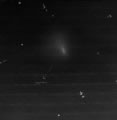

 |
 |
In this section of Nightskyhunter I would like to share a selection of comet sketches which I have made over the years of past comets. Each sketch was made while at the eyepiece of my various telescopes, binoculars, and even with the naked eye. As you can see from my own sketches you do not need to be an artist as long as you record accurately what you saw. Sketching any astronomical object is an absolutely superb way of enhancing your observing skills. Sketching teaches you to look like you have never looked before, often revealing delicate features caught during fleeting moments of good seeing. Try it for yourself!
Click on thumbnail or number to view full size image. (Identification guide below)
 |
 |
 |
||||
1 |
2 |
3 |
4 |
5 |
6 |
7 |
 |
 |
 |
 |
 |
||
8 |
9 |
10 |
11 |
12 |
13 |
14 |
 |
 |
 |
||||
15 |
16 |
17 |
18 |
19 |
20 |
21 |
 |
 |
 |
||||
22 |
23 |
24 |
25 |
26 |
27 |
28 |
 |
 |
 |
 |
|||
29 |
30 |
31 |
32 |
33 |
34 |
35 |
 |
 |
 |
 |
|||
36 |
37 |
38 |
39 |
40 |
41 |
42 |
 |
 |
 |
 |
 |
||
43 |
44 |
45 |
46 |
47 |
48 |
49 |
50 |
51 |
52 |
53 |
54 |
55 |
56 |
57 |
58 |
59 |
60 |
61 |
62 |
63 |
64 |
65 |
66 |
67 |
68 |
69 |
70 |
71 |
72 |
73 |
74 |
75 |
76 |
|
COMET DESIGNATION |
SKETCH NO. |
| C/2006 M4 SWAN | |
| C/2002 C1 IKEYA - ZHANG | |
| Comet C/1999 S4 LINEAR | |
| C/2004 Q2 MACHHOLZ | |
| C/2004 F4 BRADFIELD | |
| C/2006 A1 POJMANSKI | |
| 73P/SCHWASSMANN WACHMANN 3 | |
| C/2002 V1 NEAT | |
| C/2001 OG 108 LONEOS | |
| C/2001 A2 LINEAR | |
| C/2001 Q4 NEAT | |
| C/2005 P3 SWAN | |
| C/2003 T4 LINEAR | |
| 9P/ TEMPEL 1 | |
| C/1999 T1 Mc NAUGHT - HARTLEY | |
| C/2002 T7 LINEAR | |
| 2P/ ENCKE | 37 |
| C/2006 P1 MC NAUGHT (GREAT COMET) | 43, 44, 45, 46, 47, 48 |
| C/2007 E2 LOVEJOY | 49 |
| C/2007E1 GARRADD | 50 |
| C/2007 VZ13 LINEAR | 51 |
| C/2007 F1 LONEOS | 52, 53 , 54 , 55 , 56 , 57 , 58 , 59 , 60 |
| 17P/ Holmes | 61, 62, 63 , 64 , 65 , 69, |
| 8P/ Tuttle | 66, 67, 68, |
| 46P/ Wirtanen | 70 |
| C/2006 W3 Christensen | 71 |
| C/2006 OF2 Broughtan | 72 |
| C/2007 N3 Lulin | 73, 74, 75, 76 |
| C/2010 V1 Ikeya-Murakami | 77 |
| C/2018 V1 Machholz-Fujikawa-Iwamoto | 78 |
Sketching is something which has always been with me since I began observing over a decade ago, over the years I have compiled so many sketches that they could fill multiple photo books or journals. During this time I got in the habit of sketching everything I observed as I did not have access to any advanced cameras, so in order to have some kind of visual record in my log books I decided to document everything with pencil/pen complimented by written word. This is something I highly recommend to other observers to begin with as it provides one with the opportunity to go over past observations that convey astronomical and meteorological subjects in the manner in which the human eye-brain combination sees them. These penciled recordings are of immense sentimental value to me, not because of the quality, but because of the vivid memories which they invoke. When I first began my log book in 1997 I sketched everything from sunspots, conjunctions, galaxies, and even haloes and sundogs around the Sun. Now I sketch any new objects I find in the night sky and record the daylight phenomena with my digital camera. I do make it a priority to sketch all the comets which have entered my eyepiece as comets are my most cherished objects in the sky.
I always carry a small notepad and pen in my observing jacket. At the eyepiece I record quickly but accurately the general appearance of the comet with the background stars plotted then I make swift notes to document the time, compass point in the sky, comet magnitude, D.C, dia, colour, tails, movement etc. The following day, or later on the same night I sketch a more polished version of the comet on to a sheet of white paper before sticking it into my log book. I then simply take a digital photo of the comet sketch and invert the image to make the scene more realistic. Since some of these sketches are old the quality has degraded somewhat but I wanted to share them anyway. More comets both bright and faint will be added to this section regularly. I hope you will be tempted to start your own sketches, its worth it! Good luck.
Martin McKenna